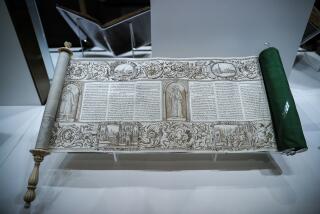Wartime secrets
- Share via
PETER HO DAVIES’ debut novel, “The Welsh Girl,” is set in the latter half of World War II in a remote village in Wales, where a secret camp is being built. This causes much excitement in the village, particularly for Esther, a young barmaid who has fallen for one of the English soldiers constructing the camp.
Their dalliance is particularly volatile because Esther’s father is a staunch Welsh nationalist who views the English as nothing more than oppressors. Esther’s soldier, Colin, promptly seduces her and spills his seed as well as the secret that the camp is for German prisoners of war. Soon after, Esther has a secret of her own.
Auf Wiedersehen, Colin; enter Karsten, a dashing, blond German officer who surrendered himself and his men. Despite his fluency in English, Karsten has a rough go of it in the POW camp because he carries the secret shame of the capitulator -- the hateful cousin of survivor’s guilt. Poor Karsten is afflicted with a self-loathing not seen since Joseph Conrad’s “Lord Jim” took a swan dive off the fantail of the Patna, leaving hundreds of the pilgrim ship’s passengers to drown.
As the novel’s chapters alternate between Esther and Karsten, the two characters are inexorably drawn together, until the barbed wire that separates the prisoner inside the camp from the woman inside her tyrannical father’s home becomes metaphor-thin. Of course, Karsten escapes and the two come face to face.
It seems a foregone conclusion that Esther and Karsten will get busy in the haymow, which they do. But after hiding out in Esther’s father’s barn for a few days, eating food that she prepares for him, Karsten decides to give himself up -- again -- and is returned to camp. Esther’s feelings about this are complicated, but mostly she’s relieved. She does, after all, have a baby on the way.
A curious wrinkle in Davies’ narrative concerns Capt. Rotheram, an officer in the British intelligence service and son of a German-Jewish World War I hero who is sent to a safe house in Wales to interrogate Rudolf Hess, the member of Hitler’s inner circle who famously flew the coop in a Messerschmitt fighter. Hess touched down in Scotland in 1941, apparently in an ill-conceived attempt to negotiate peace with Britain. The Fuhrer dismissed Hess as a lunatic. Hess professed amnesia and Churchill had him locked up for the war’s duration in a series of locations in Wales.
Because so little is known about Hess’ motives, he is an excellent subject for a work of historical fiction. Pairing him with an interrogator conflicted about his own identity and in denial about his Jewish ancestry is a masterstroke. But does that story belong in a novel about a shepherd’s daughter?
Davies seems uncertain. Esther, the Welsh girl of the title, is the novel’s main character, but aside from her fascination with Karsten she has nothing to do with the Rotheram-Hess subplot. Rotheram turns up briefly at the camp, where he is sent to help find the missing Karsten.
Davies previously published excerpts of the novel in a number of periodicals, and as late as 2004, it was tentatively titled “The Bad Shepherd,” suggesting that at least for a while the main character was not Esther. The author’s indecisiveness about his main character is telling. Davies, who has a background in the sciences, has said in published interviews that he wrote multiple drafts of the novel from numerous perspectives, as if he were conducting an experiment.
Davies’ previous books have been the short-story collections “Equal Love” and “The Ugliest House in the World,” for which he won numerous accolades and awards. He has a knack for evoking the telling detail but at times falls prey to the quick and easy characterization: the English soldier who is “glossily handsome, like the lobby card of a film star,” or the bartender wounded in the Great War who walks with a limp but has “never spilled a drop.” Indeed, when we first meet Esther she compares the emotions she feels about Colin to the slow pouring of a pint of Guinness, a sentiment that errs on the treacly side of sweet.
Nevertheless, Davies’ characters are marvelously nuanced. The book’s three major figures suffer from severe identity conflict.
Esther must shield the identity of her baby’s English father from her own father, so she invents a relationship with the village’s only war casualty. Karsten, the son of a fallen war hero, struggles in vain to fill his father’s shoes and win his mother’s approval. Rotheram tells everyone who will listen that he’s not Jewish, until the denials transcend falsehood and become farcical. Each character could carry the novel, but Davies’ hero-by-committee approach falls short.
For instance, what are we to make of Rotheram? The novel begins and ends with him, and it is through him that we learn the fate of all the characters, including the one Esther carries in her belly. We first encounter Rotheram in a prologue set in September 1944, well after the events of the novel’s early chapters; so why call it a prologue if the events occur out of sequence? Rotheram returns to the narrative when we learn of Karsten’s escape, but by this time nearly 200 pages have passed and his appearance seems sudden and forced.
Rotheram makes his final appearance in the epilogue, which runs from the war’s conclusion to the end of his career and includes a brilliant scene with Hess and one very angry bull.
If the novel’s organization is a bit of a muddle, by the end of the epilogue, all questions have been resolved and the earlier missteps redeemed. We even follow Hess to his cell in West Berlin’s Spandau Prison, where he committed suicide in 1987 at age 93, a cipher to the end -- a perfect metaphor for Davies’ Wales. *
More to Read
Sign up for our Book Club newsletter
Get the latest news, events and more from the Los Angeles Times Book Club, and help us get L.A. reading and talking.
You may occasionally receive promotional content from the Los Angeles Times.










